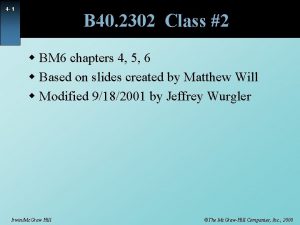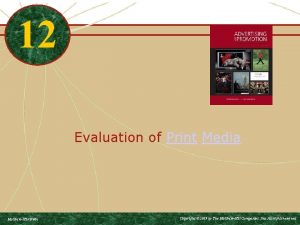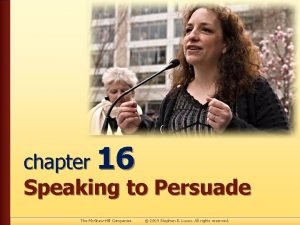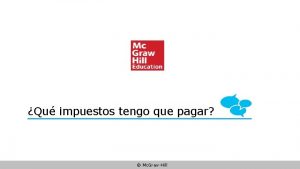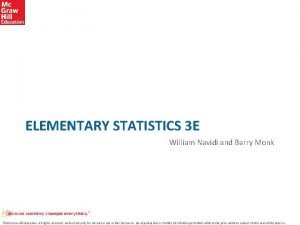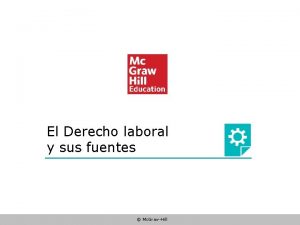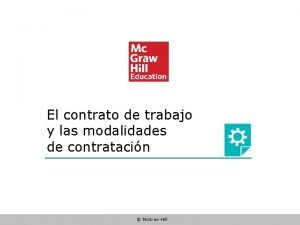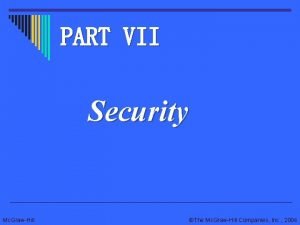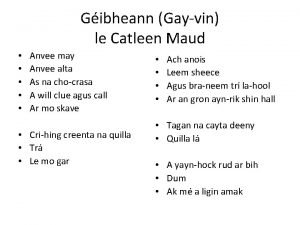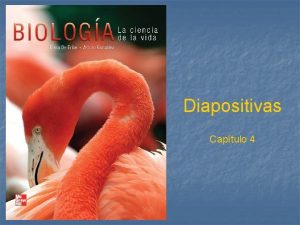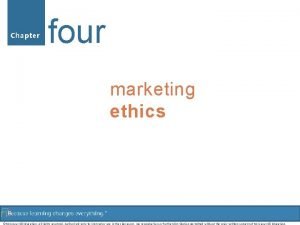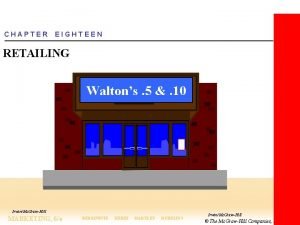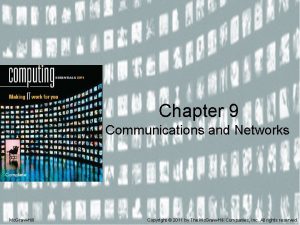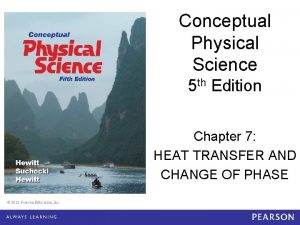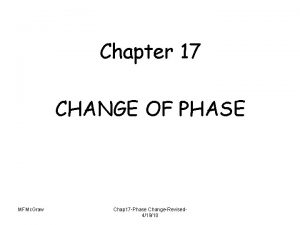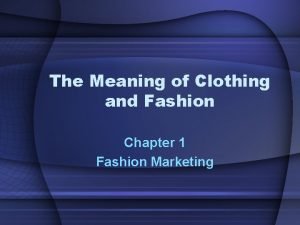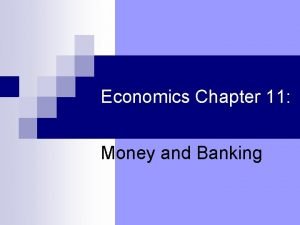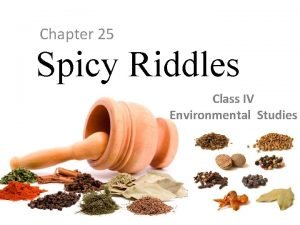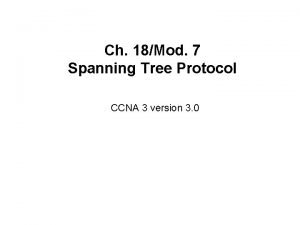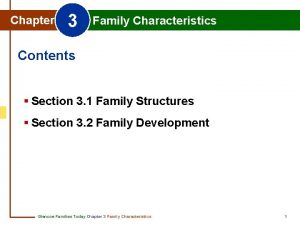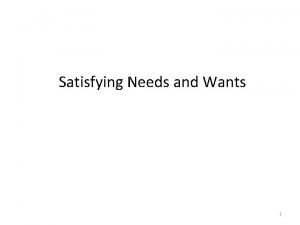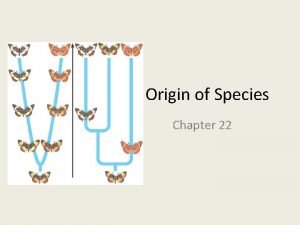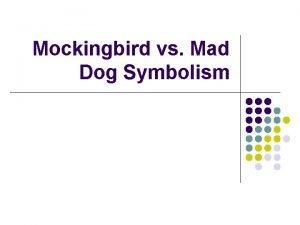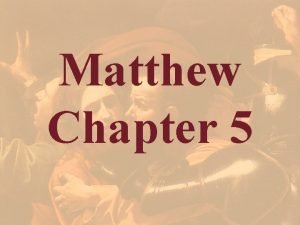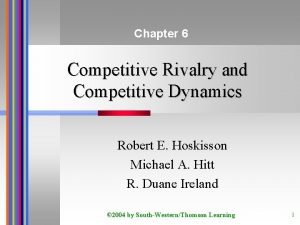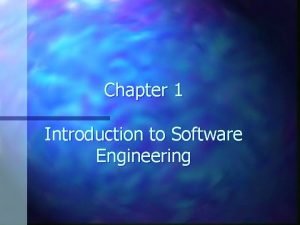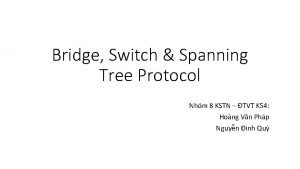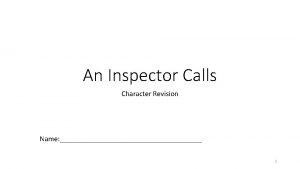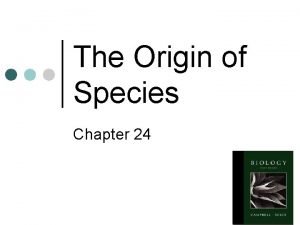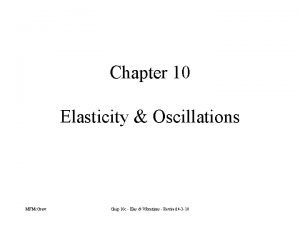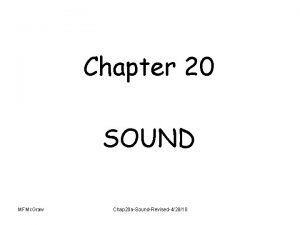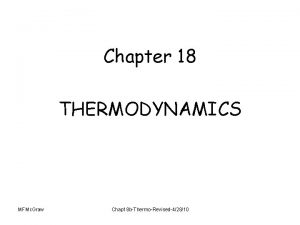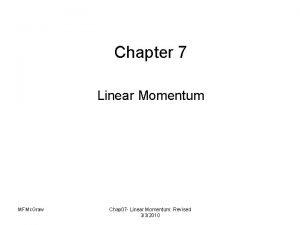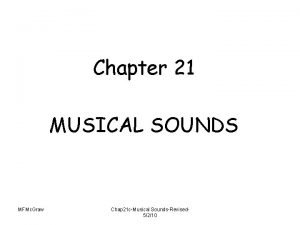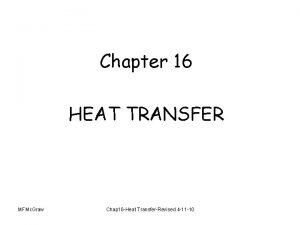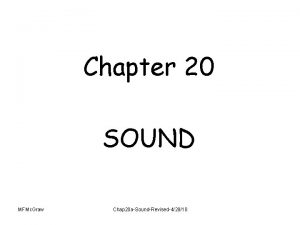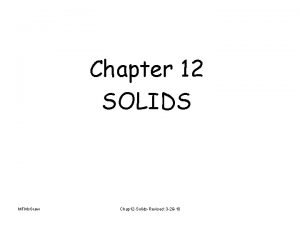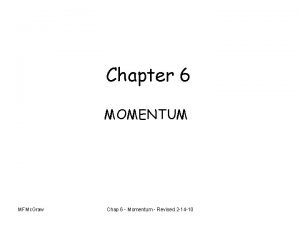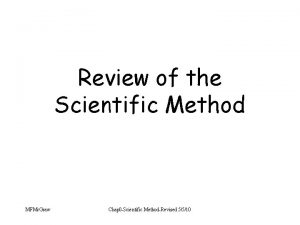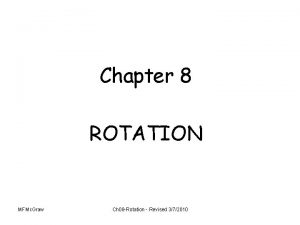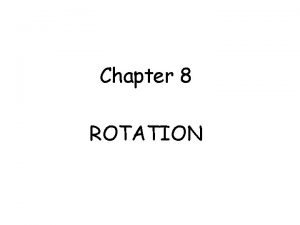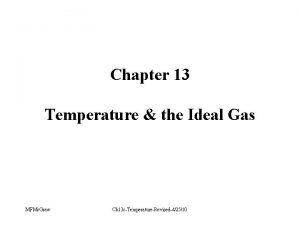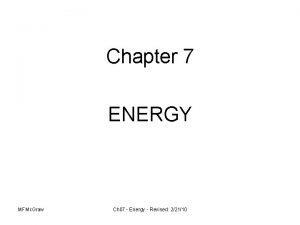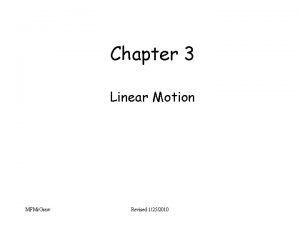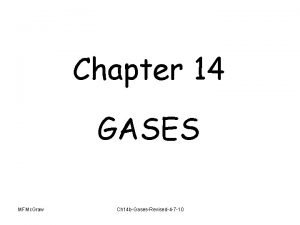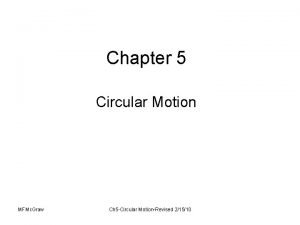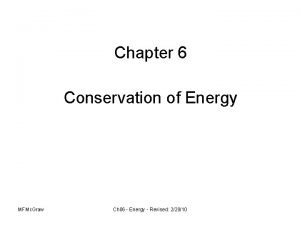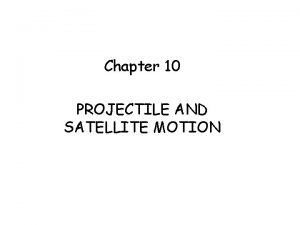Chapter 23 CHANGE OF PHASE MFMc Graw Chap



















































- Slides: 51

Chapter 23 CHANGE OF PHASE MFMc. Graw Chap 17 -Phase Change-Revised 4/19/10 1

This lecture will help you understand: • • • MFMc. Graw Phases of Matter Evaporation Condensation Boiling Melting and Freezing Energy and Changes of Phase Chap 17 -Phase Change-Revised 4/19/10 2

Phases of Matter exists in four common phases that involve transfer of internal energy: • Solid phase (ice) • Liquid phase (ice melts to water) • Gaseous phase (addition of more energy turns water to vapor) • Plasma phase (with the addition of much energy the molecules of vapor dissociate into a charged gas of ions and electrons) MFMc. Graw Chap 17 -Phase Change-Revised 4/19/10 3

Phases of Matter • The phase of matter depends upon the temperature and pressure. • Change from Solid Liquid Gas Plasma requires energy to be added to the material. • Energy causes the molecules to move more rapidly. MFMc. Graw Chap 17 -Phase Change-Revised 4/19/10 4

Evaporation • Change of phase from liquid to gas MFMc. Graw Chap 17 -Phase Change-Revised 4/19/10 5

Evaporation • Molecules in liquid move randomly at various speeds, continually colliding into one another. • Some energetic molecules escape from the liquid and become gas. • **Boiling is evaporation happening really fast!!! • Average kinetic energy of the remaining molecules in the liquid decreases, resulting in cooler water. Or preventing the temperature from increasing. MFMc. Graw Chap 17 -Phase Change-Revised 4/19/10 6

The molecules in a room-temperature glass of water jostle around at • a. a great variety of speeds. • b. much the same rates of speed. • c. no speed (they are not moving). MFMc. Graw Chap 17 -Phase Change-Revised 4/19/10 7

• What would happen if all water molecules had the same jiggling speed at… • 100 deg C • 0 deg C MFMc. Graw Chap 17 -Phase Change-Revised 4/19/10 8

Evaporation Important in cooling our bodies when we overheat • Sweat glands produce perspiration. • Water on our skin absorbs body heat as evaporation cools the body. • Helps to maintain a stable body temperature. MFMc. Graw Chap 17 -Phase Change-Revised 4/19/10 9

• • • Condensation occurs when matter changes from a a. gas to a liquid. b. solid to a gas. c. solid to a liquid. d. liquid to a gas. e. gas to a solid. MFMc. Graw Chap 17 -Phase Change-Revised 4/19/10 10

Sublimation is a phase transition that proceeds directly from the solid state to the gaseous state without going through the liquid state. Examples: • dry ice (solid carbon dioxide molecules) • mothballs • frozen water (at subatmospheric pressure) MFMc. Graw Chap 17 -Phase Change-Revised 4/19/10 11

• Sublimation would ____ the surrounding air. • A. Warm • B. Cool • C. neither MFMc. Graw Chap 17 -Phase Change-Revised 4/19/10 12

Condensation process • • Opposite of evaporation Warming process from a gas to a liquid Gas molecules near a liquid surface are attracted to the liquid They strike the surface with increased kinetic energy, becoming part of the liquid MFMc. Graw Chap 17 -Phase Change-Revised 4/19/10 13

Condensation process (continued) • Kinetic energy is absorbed by the liquid, resulting in increased temperature. Examples: • Steam releases much energy when it condenses to a liquid and moistens the skin—hence, it produces a more damaging burn than from same-temperature 100 C boiling water. • You feel warmer in a moist shower stall because the rate of condensation exceeds the rate of evaporation. MFMc. Graw Chap 17 -Phase Change-Revised 4/19/10 14

• Which would make a more painful burn 100 deg water or 100 deg steam? • A. water • B. Steam • C. A really mad cat MFMc. Graw Chap 17 -Phase Change-Revised 4/19/10 15

• When water vapor condenses on the inside of a window, the window becomes • a. slightly warmer. • b. neither warmer nor cooler. • c. slightly cooler. MFMc. Graw Chap 17 -Phase Change-Revised 4/19/10 16

Condensation process (continued) Examples: • In dry cities, the rate of evaporation from your skin is greater than the rate of condensation, so you feel colder. • In humid cities, the rate of evaporation from your skin is less than the rate of condensation, so you feel warmer. • A cold soda pop can is wet in warm air because slow-moving molecules make contact with the cold surface and condense. MFMc. Graw Chap 17 -Phase Change-Revised 4/19/10 17

Melting snow • a. neither warms nor cools the surrounding air. • b. warms the surrounding air. • c. cools the surrounding air. MFMc. Graw Chap 17 -Phase Change-Revised 4/19/10 18

Change of Phase CHECK YOUR NEIGHBOR If bits of coals do not stick to your feet when firewalking, it’s best if your feet are • B. C. D. wet. dry. sort of wet and sort of dry. None of these. MFMc. Graw Chap 17 -Phase Change-Revised 4/19/10 19

Change of Phase CHECK YOUR ANSWER If bits of coals do not stick to your feet when firewalking, it’s best if your feet are • B. C. D. wet. dry. sort of wet and sort of dry. None of these. Explanation: The energy that vaporizes water is energy that doesn’t burn your feet. MFMc. Graw Chap 17 -Phase Change-Revised 4/19/10 20

Condensation CHECK YOUR NEIGHBOR When you step out after a hot shower you feel cold, but you can feel warm again if you step back into the shower area. Which process is responsible for this? A. B. C. D. Evaporation Condensation Both of these. None of the above. MFMc. Graw Chap 17 -Phase Change-Revised 4/19/10 21

Condensation CHECK YOUR ANSWER When you step out after a hot shower you feel cold, but you can feel warm again if you step back into the shower area. Which process is responsible for this? A. B. C. D. Evaporation Condensation Both of these. None of the above. MFMc. Graw Explanation: When you step back into the shower area, the steam that is present condenses on your body, causing it to warm up. Chap 17 -Phase Change-Revised 4/19/10 22

Boiling process • Rapid evaporation from beneath the surface of a liquid. MFMc. Graw Chap 17 -Phase Change-Revised 4/19/10 23

Boiling process (continued) • Rapid form of evaporation beneath the surface forms vapor bubbles (NOT AIR). • Bubbles rise to the surface. • If vapor pressure in the bubble is less than the surrounding pressure, then the bubbles collapse. • Hence, bubbles don’t form at temperatures below boiling point (vapor pressure is insufficient). MFMc. Graw Chap 17 -Phase Change-Revised 4/19/10 24

Boiling process (continued) • Boiling water at 100 C is in thermal equilibrium—boiling water is being cooled as fast as it is being warmed. • In this sense, boiling is a cooling process. MFMc. Graw Chap 17 -Phase Change-Revised 4/19/10 25

Boiling • Boiling point depends on pressure. Example: Buildup of vapor pressure inside a pressure cooker prevents boiling, thus resulting in a higher temperature that cooks the food. • Boiling point is lower with lower atmospheric pressure. Example: Water boils at 95 C in Denver, CO (high altitude) instead of at 100 C (sea level). MFMc. Graw Chap 17 -Phase Change-Revised 4/19/10 26

Boiling Point Pressure Dependent MFMc. Graw Chap 17 -Phase Change-Revised 4/19/10 27

Boiling CHECK YOUR NEIGHBOR The process of boiling A. B. C. D. cools the water being boiled. depends on atmospheric pressure. is a change of phase below the water surface. All of the above. MFMc. Graw Chap 17 -Phase Change-Revised 4/19/10 28

Boiling CHECK YOUR ANSWER The process of boiling • B. C. D. cools the water being boiled. depends on atmospheric pressure. is a change of phase below the water surface. All of the above. MFMc. Graw Chap 17 -Phase Change-Revised 4/19/10 29

Melting and Freezing Melting • Occurs when a substance changes phase from a solid to a liquid • Opposite of freezing • When heat is supplied to a solid, added vibration breaks molecules loose from the structure and melting occurs. MFMc. Graw Chap 17 -Phase Change-Revised 4/19/10 30

Melting and Freezing • Occurs when a liquid changes to a solid • Opposite of melting • When energy is continually removed from a liquid, molecular motion decreases until the forces of attraction bind them together and formation of ice occurs. MFMc. Graw Chap 17 -Phase Change-Revised 4/19/10 31

Melting takes energy from the environment • Freezing adds energy to the environment • The heat of fusion for water at 0 °C is approximately 334 joules (79. 7 calories) per gram, and the heat of vaporization at 100 °C is about 2, 230 joules (533 calories) per gram. Mar 22, 2016 • Grandfather’s root cellar MFMc. Graw Chap 17 -Phase Change-Revised 4/19/10 32

Energy and Change of Phase • From solid to liquid to gas phase – add energy • From gas to liquid to solid phase – remove energy MFMc. Graw Chap 17 -Phase Change-Revised 4/19/10 33

Energy and Change of Phase • Cooling cycle of refrigerator pumps a special fluid that vaporizes and draws heat from stored food. The gas that forms, along with its energy, is directed to the condensation coils outside the fridge where heat is released and the fluid condenses back to liquid. MFMc. Graw Chap 17 -Phase Change-Revised 4/19/10 34

• The cooling effect inside a refrigerator is produced by • a. compressing the refrigeration gas into a liquid. • b. vaporizing the refrigeration liquid. • c. an electric motor that converts electrical energy into thermal energy. • d. proper insulation. • e. none of the above MFMc. Graw Chap 17 -Phase Change-Revised 4/19/10 35

Energy and Change of Phase Heat of fusion • Amount of energy needed to change any substance from solid to liquid and vice versa Examples: • Heat of fusion for water is 334 joules/g. • Farmers in cold climates replace frozen tubs of water with unfrozen ones in their cellars to prevent jars of food from freezing. MFMc. Graw Chap 17 -Phase Change-Revised 4/19/10 36

Energy and Change of Phase Heat of vaporization • Amount of energy needed to change any substance from liquid to gas and vice versa Examples: • Heat of vaporization for water is 2256 joules/g. • In briefly touching a hot skillet, energy that normally would flow into your finger instead vaporizes water. Hence, you’re not burned. MFMc. Graw Chap 17 -Phase Change-Revised 4/19/10 37

From Cold Ice to Hot Steam MFMc. Graw Chap 17 -Phase Change-Revised 4/19/10 38

Energy and Change of Phase CHECK YOUR NEIGHBOR When snow forms in clouds, the surrounding air is A. B. C. D. cooled. warmed. insulated. thermally conducting. MFMc. Graw Chap 17 -Phase Change-Revised 4/19/10 39

Energy and Change of Phase CHECK YOUR ANSWER When snow forms in clouds, the surrounding air is • B. C. D. cooled. warmed. insulated. thermally conducting. Explanation: The change of phase is from gas to solid, which releases energy. MFMc. Graw Chap 17 -Phase Change-Revised 4/19/10 40

Energy and Change of Phase CHECK YOUR NEIGHBOR Which involves the greatest number of calories? A. Condensing 1 gram of 100 C steam to 100 water B. Cooling 1 gram of 100 C water to 1 gram of 0 C ice C. Cooling 1 gram of 0 C ice to near absolute zero D. All about the same. MFMc. Graw Chap 17 -Phase Change-Revised 4/19/10 41

Energy and Change of Phase CHECK YOUR ANSWER Which involves the greatest number of calories? • B. C. D. Condensing 1 gram of 100 C steam to 100 C water Cooling 1 gram of 100 C water to 1 gram of 0 C ice Cooling 1 gram of 0 C ice to near absolute zero All about the same. Explanation: 540 calories is more than the 100 calories for B, and half of 273 calories to cool ice (the specific heat of ice is about half that for liquid water). MFMc. Graw Chap 17 -Phase Change-Revised 4/19/10 42

Energy and Change of Phase CHECK YOUR NEIGHBOR Ice is put in a picnic cooler. To speed up the cooling of cans of beverage, it is important that the ice A. B. C. D. melts. is prevented from melting. be in large chunks. None of the above. MFMc. Graw Chap 17 -Phase Change-Revised 4/19/10 43

Energy and Change of Phase CHECK YOUR ANSWER Ice is put in a picnic cooler. To speed up the cooling of cans of beverage, it is important that the ice B. C. D. melts. is prevented from melting. be in large chunks. None of the above. Explanation: For each gram of ice that melts, 540 calories is taken from the beverage. MFMc. Graw Chap 17 -Phase Change-Revised 4/19/10 44

• • At high altitudes, the boiling point of water a. is lower. b. stays the same. c. is higher. MFMc. Graw Chap 17 -Phase Change-Revised 4/19/10 45

When heat is added to boiling water, the temperature of the boiling water • a. decreases. • b. stays the same. • c. increases. MFMc. Graw Chap 17 -Phase Change-Revised 4/19/10 46

MFMc. Graw Chap 17 -Phase Change-Revised 4/19/10 47

The cooling effect inside a refrigerator is produced by • a. compressing the refrigeration gas into a liquid. • b. vaporizing the refrigeration liquid. • c. an electric motor that converts electrical energy into thermal energy. • d. proper insulation. • e. none of the above MFMc. Graw Chap 17 -Phase Change-Revised 4/19/10 48

Summary • • • MFMc. Graw Phases of Matter Evaporation Condensation Boiling Melting and Freezing Energy and Changes of Phase Chap 17 -Phase Change-Revised 4/19/10 49

Triple Point Demo A triple point demo using dry ice in a closed bottle under an overturned beaker. As the solid CO 2 evaporated, enough pressure built up for the solid sample to begin liquefying. Source: http: //condor. depaul. edu/~jmilton/Rem 042007/rem 042007. html MFMc. Graw Chap 17 -Phase Change-Revised 4/19/10 50

Source: http: //www. youtube. com/watch? v=p. OYgd. Qp 4 euc&NR=1 MFMc. Graw Chap 17 -Phase Change-Revised 4/19/10 51
 Chap chap slide
Chap chap slide What is flaw graw
What is flaw graw Operations management is defined as
Operations management is defined as Freshwater ecosystems are classified as
Freshwater ecosystems are classified as Evaluation of print media
Evaluation of print media Monroe's motivated sequence
Monroe's motivated sequence Suzanne graw
Suzanne graw Mc graw hill education
Mc graw hill education Mc graw hill education
Mc graw hill education Area principle statistics
Area principle statistics Fuentes del derecho laboral internas y externas
Fuentes del derecho laboral internas y externas Mc graw hill education
Mc graw hill education Mc graw hill
Mc graw hill Gonall
Gonall Mc graw hill
Mc graw hill Flaw graw
Flaw graw Retail positioning matrix
Retail positioning matrix Define graw
Define graw Graw outlet
Graw outlet Chapter 23 change of phase
Chapter 23 change of phase Chapter 7 heat transfer and change of phase
Chapter 7 heat transfer and change of phase Conceptual physics chapter 17 change of phase answers
Conceptual physics chapter 17 change of phase answers Normal phase vs reverse phase chromatography
Normal phase vs reverse phase chromatography Hplc reverse phase vs normal phase
Hplc reverse phase vs normal phase Mobile phase and stationary phase
Mobile phase and stationary phase Chromatography means
Chromatography means Normal phase vs reverse phase chromatography
Normal phase vs reverse phase chromatography Phase to phase voltage
Phase to phase voltage Adsorption chromatography
Adsorption chromatography In a ∆-connected source feeding a y-connected load
In a ∆-connected source feeding a y-connected load Broad phase vs narrow phase
Broad phase vs narrow phase 1 of 1 clothing meaning
1 of 1 clothing meaning Passion chap 6
Passion chap 6 Bank run chap 11
Bank run chap 11 Autocorrelation in econometrics
Autocorrelation in econometrics Small and round like a pearl i am black when i am whole
Small and round like a pearl i am black when i am whole Kstn chap 18
Kstn chap 18 Family control ch3
Family control ch3 The origin of species chapter 24 manga
The origin of species chapter 24 manga Items purchased to satisfy needs and wants
Items purchased to satisfy needs and wants The origin of species chapter 22 bl
The origin of species chapter 22 bl What does the mad dog symbolize in to kill a mockingbird
What does the mad dog symbolize in to kill a mockingbird Matthew 5
Matthew 5 Chapter 1 learning about children
Chapter 1 learning about children Rivalry chapter 6
Rivalry chapter 6 System engineer chap 1
System engineer chap 1 Chap tree
Chap tree Kstn chap 7
Kstn chap 7 I was in that state when a chap easily turns nasty analysis
I was in that state when a chap easily turns nasty analysis The origin of species manga 24
The origin of species manga 24 Passion chap 9
Passion chap 9 Bài tập về nhà
Bài tập về nhà

